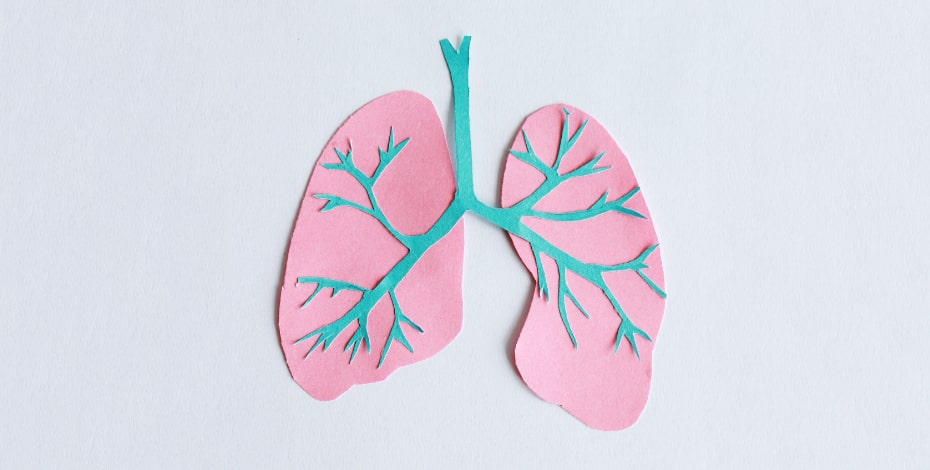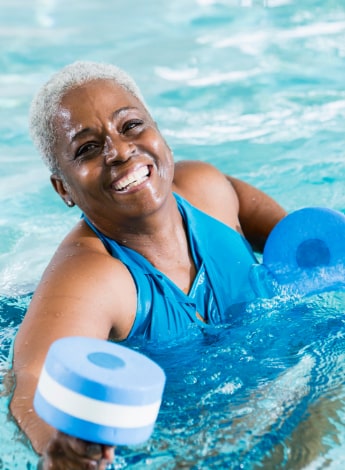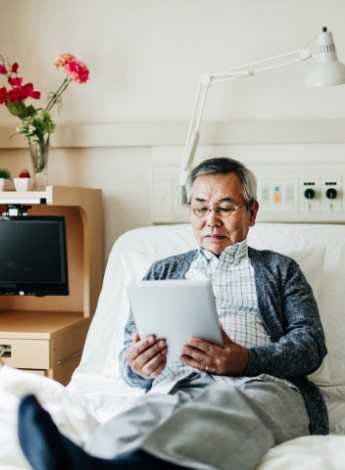
Five facts about … pulmonary rehabilitation

To mark World COPD Day this month, Meredith King and Sonia Cheng from the APA Cardiorespiratory national group highlight five discussion points about the role of physiotherapy in pulmonary rehabilitation.
1. Pulmonary rehabilitation (PR) improves exercise capacity and quality of life and reduces breathlessness in people with chronic lung disease
PR is one of the most important things that somebody with a chronic lung disease can do to improve their health.
People with chronic lung diseases often have symptoms that include breathlessness, fatigue and difficulty completing their usual activities.
PR programs involve exercise sessions in various different formats including gym sessions, water-based exercise or home programs and, at some centres, include education sessions.
PR has very strong evidence in chronic obstructive pulmonary disease (COPD) (McCarthy et al 2015), bronchiectasis and interstitial lung disease (ILD) in improving exercise capacity and reducing symptoms, and it is recommended that everyone with a chronic lung disease who has symptoms participates in a rehabilitation program to improve their wellbeing (Allison et al 2017).
It is highly cost-effective compared with other common therapies such as inhaled medications, and has been shown to reduce healthcare costs by reducing hospital admissions and length of stay in people with COPD.
Unfortunately referrals to, and uptake of, PR remains low due to a variety of barriers, including low awareness and difficulty for people to access the programs such as parking near hospitals. Research directions are now including trialling alternative methods of PR delivery to enhance uptake.

2. PR can be done remotely via telehealth and apps
To improve uptake of PR, telerehabilitation and apps have been investigated.
Telerehabilitation—group exercise sessions through videoconferencing technology—has been shown to be effective in improving exercise capacity in COPD and chronic heart failure.
These programs have typically had small groups of participants (four to six at a time) joining their physiotherapist online to complete exercises at home in a similar structure to outpatient PR programs.
So far, this option has been well tolerated with good completion rates and minimal adverse events (Tsai et al 2016, Hwang et al 2017).
This structure has been rolled out more widely in 2020 due to the pandemic, and is allowing PR programs to continue across Australia when face-to-face sessions were not possible.
It has already been established that a significant portion of people undertaking PR had some level of confidence using technology, so implementing telerehabilitation into usual practice is a natural progression.
Other studies have successfully run PR programs through setting up home exercise programs for people with chronic lung disease and completing weekly phone calls using motivational interviewing techniques to improve participation.
Use of app technology is the next frontier in progressing PR uptake.
Mobile apps have been shown to be effective in cardiac rehabilitation populations and PR apps are already being used overseas. An Australian app is currently under development.
3. Exercise capacity can be assessed in the home or remotely
With the current pandemic limiting face-to-face outpatient appointments in some locations, focus has shifted to reliably assess a person’s exercise capacity either in their home or via remote technology (Holland et al 2020).
Six-minute walk tests (6MWT) are the most common field-walking test used in Australia and it has been shown to be feasible to do in a person’s home and remotely using apps.
However, the results in the home were shown to be lower than when completed in the outpatient clinic, likely due to the difference in track length, so care must be taken to reassess on the same track to monitor progress.
Sit-to-stand tests such as the 5STS and 1-minute STS appear to be reliable in the person’s home, and the 1-minute STS test correlates well with the 6MWT and could potentially be used to guide aerobic exercise prescription.
Finally, step tests such as the incremental step test and 3-minute step test also appear to be feasible at home, and the 3MST was reliable remotely (Cox et al 2013).
Each exercise test has different benefits depending on what type of information will be most useful in order to start a PR program remotely or in the home—so use your clinical judgement but there are plenty of opportunities to provide fantastic clinical care during strange circumstances.

4. An individualised PR program offering exercise and education modules may improve completion rates compared to traditional PR
For those who are both referred to and attend an outpatient PR program, completion rates vary from 69 to 77 per cent (Fischer et al 2007, Garrod et al 2006).
Patient-reported barriers that may impede successful completion of PR include unwillingness to travel, insufficient perceived benefit of the program, lack of social support at home, and health and weather factors (Lima et al 2016, Oates et al 2019, Arnold et al 2006).
Observational studies in the United Kingdom and the Netherlands have also identified several predictors for non-attendance and early dropout from PR, including symptoms of depression and anxiety, longer patient travel times, being a smoker and more severe disease and dyspnoea at baseline (Fischer et al 2009, Fan et al 2008).
Placing a greater emphasis on patient preference and providing choice of rehabilitation options may increase PR completion rates.
Following eligibility and safety screening during initial assessment, a program in Australia offers patients a choice of three supervised group exercise training modules—conventional gym-based exercise training, water-based exercise training or home-based real-time videoconferencing telerehabilitation.
Patients are allocated to one or more individual or group education modules based on their medical history and lung disease knowledge (McNamara et al 2019).
The PuReMod trial examined the feasibility of such a program with personalised exercise and education modules in 169 participants enrolled in a hospital-based program in Sydney (McNamara et al 2020).
Compared with the historical traditional PR group, participants attending the modular PR program had significantly higher completion rates (66 vs 56 per cent) and achieved similar improvements in six-minute walk distance and patient knowledge on the Lung Information Needs Questionnaire exceeding the minimally important clinical difference.
This modular approach to PR is becoming standard clinical practice in many metropolitan centre-based programs in Australia. Models of care which focus on patient enjoyment and choice may broaden the appeal and reduce the high dropout rate of traditional centre-based PR programs.

5. Patient education videos assist with uptake of PR in people with COPD following an acute exacerbation
Uptake of PR is particularly low following an acute exacerbation of COPD, with only 2–10 per cent of all eligible patients receiving PR within 12 months of hospitalisation (Spitzer et al 2019, Jones et al 2014).
Since lack of both awareness and perceived benefit of PR are commonly reported patient barriers to uptake (Cox et al 2017), patient co-designed education videos describing the benefits, as well as information on program location, transport and parking options may be a low cost and easily implemented to increase the uptake or PR from acute hospital and primary care settings.
Effectiveness of patient education videos on referral, uptake and completion of PR following hospitalisation has been examined in one randomised controlled trial in the United Kingdom (Barker et al 2020).
Of 196 participants with COPD, of which 48 per cent were with COPD, of which 48 per cent were naïve to PR, patient education videos shown at hospital discharge had no effect on referral, uptake or completion of PR compared with usual care.
Qualitative interviews conducted with 15 participants in the study revealed almost half were unable to recall watching the video at hospital discharge, suggesting the timing was inappropriate for some participants.
Of the eight participants who did not take up PR, the reasons for non- attendance were feeling too unwell, lack of perceived need for further exercise, lack of transport, and other medical or social issues taking priority over PR.
More comprehensive behavioural interventions designed to educate patients, staff or carers may be needed to increase uptake of PR following hospitalisation.
Patient education videos may still prove to be a valuable component of such interventions.
Want an infographic poster version? Click here to download.
Meredith King, APAM, is the national chair of the APA Cardiorespiratory Group. Meredith works clinically in Sydney in pulmonary and heart failure.
Sonia Cheng is the chair of the APA NSW Cardiorespiratory Group. Sonia is a lecturer at the University of Sydney and works at Royal Prince Alfred and Westmead hospitals in acute care.
References
McCarthy, B., et al. Pulmonary rehabilitation for chronic obstructive pulmonary disease. Cochrane Database of Systematic Reviews, 2015, Issue 2.
Alison, J.A., et al. and on behalf of the Lung Foundation Australia and the Thoracic Society of Australia and New Zealand. Australian and New Zealand Pulmonary Rehabilitation Guidelines. Respirology, 2017. 22: p.800– 819.
Tsai, L.L.Y., et al. Home‐based telerehabilitation via real‐time videoconferencing improves endurance exercise capacity in patients with COPD: The randomized controlled TeleR Study. Respirology, 2016. 22, p. 699– 707.
Hwang, R., et al. Home-based telerehabilitation is not inferior to a centre-based program in patients with chronic heart failure: a randomised trial. Journal of Physiotherapy, 2017. 63(2): p.101-107.
Holland A.E., et al. An official European Respiratory Society/American Thoracic Society technical standard: field walking tests in chronic respiratory disease. European Respiratory Journal. 2014; 44(6): p.1429-46.
Cox, N.S., et al. Assessing Exercise Capacity Using Telehealth: A Feasibility Study in Adults With Cystic Fibrosis. Respiratory Care, 2013. 58(2): p. 286-290.
Fischer, M.J., et al., Participation and drop-out in pulmonary rehabilitation: a qualitative analysis of the patient's perspective. Clinical Rehabilitation, 2007. 21(3): p. 212-221.
Garrod, R., Predictors of success and failure in pulmonary rehabilitation. European Respiratory Journal, 2006. 27(4): p. 788-794.
Lima, F., et al., Factors influencing participation and adherence to a pulmonary rehabilitation program in patients with COPD: A qualitative study. European Respiratory Journal, 2016. 48(suppl 60): p. PA1901.
Oates, G.R., et al., Adherence to Pulmonary Rehabilitation in COPD. Journal of Cardiopulmonary Rehabilitation and Prevention, 2019. 39(5): p. 344-349.
Arnold, E., A. Bruton, and C. Ellis-Hill, Adherence to pulmonary rehabilitation: A qualitative study. Respiratory Medicine, 2006. 100(10): p. 1716-1723.
Fischer, M.J., et al., Drop-out and attendance in pulmonary rehabilitation: The role of clinical and psychosocial variables. Respiratory Medicine, 2009. 103(10): p. 1564-1571.
Fan, V.S., et al., Costs of Pulmonary Rehabilitation and Predictors of Adherence in the National Emphysema Treatment Trial. COPD: Journal of Chronic Obstructive Pulmonary Disease, 2008. 5(2): p. 105-116.
McNamara, R.J., M. Dale, and Z.J. McKeough, Innovative strategies to improve the reach and engagement in pulmonary rehabilitation. Journal of Thoracic Disease, 2019. 11(S17): p. S2192-S2199.
McNamara R, Tsai L, Santos M, Alison J. Improving pulmonary rehabilitation completion with personalised exercise and education modules: the PuReMod trial. European Respiratory Society International Virtual Congress; September 2020.
Jones, S.E., et al., Pulmonary rehabilitation following hospitalisation for acute exacerbation of COPD: referrals, uptake and adherence. Thorax, 2014. 69(2): p. 181-182.
Cox, N.S., et al., Pulmonary rehabilitation referral and participation are commonly influenced by environment, knowledge, and beliefs about consequences: a systematic review using the Theoretical Domains Framework. Journal of Physiotherapy, 2017. 63(2): p. 84-93.
Barker, R.E., et al., The Effects of a Video Intervention on Posthospitalization Pulmonary Rehabilitation Uptake. A Randomized Controlled Trial. American Journal of Respiratory and Critical Care Medicine, 2020. 201(12): p. 1517-1524.
© Copyright 2024 by Australian Physiotherapy Association. All rights reserved.





